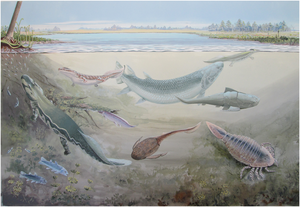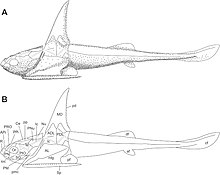Waterloo Farm lagerstätte


The Waterloo Farm lagerstätte is a Famennian lagerstätte in South Africa that constitutes the only known record of a near-polar Devonian coastal ecosystem.
History and discovery



The Waterloo Farm
Uprisings against the
By the mid-90’s, the road cutting was frequently collapsing due to the dip direction of the strata being towards the road.
The fossils are housed and researched by the Devonian Ecosystems project, (funded by the Millennium Trust and South African Centre of Excellence in Palaeosciences) in the Albany Museum’s Devonian lab at 87 Beaufort Street, Makhanda (formerly Rhini or Grahamstown). They have provided the material for extensive research by Dr Rob Gess and his collaborators, and an ongoing stream of significant papers.[1][6][7][8]
Contributions to palaeontological material
Waterloo Farm is a globally significant site, providing the only record of a high latitude (near polar) coastal ecosystem, overturning numerous assumptions about high latitude conditions during the latest Devonian.
Site characteristics


Witpoort Formation black shales within the Eastern Cape often exhibit cyclical changes in composition, which likely reflect (potentially seasonal) fluctuations in water salinity. Water stratification within the estuarine lake frequently led to anoxic bottom waters, resulting in episodes of exceptional preservation.[14]
Witpoort Formation sediments were deeply buried due to continued basinal subsidence through the
Fossils
More than 20 species new to science have been named from Waterloo Farm, which probably represent about a third of the total number of
Other species represented include several species of armour plated (
Paleobiota
Animalia
Vertebrata
Agnatha
| Agnatha | |||
|---|---|---|---|
| Genus | Species | Notes | Images |
| Priscomyzon[20] | P. riniensis | The oldest known lamprey, known from multiple growth series.[7] |  |
Placodermi
| Placodermi | |||
|---|---|---|---|
| Genus | Species | Notes | Images |
| Bothriolepis[22] | B. africana | paleolatitude .
|
 |
| Groenlandaspis[22] | G. riniensis | A arthrodiran placoderm. Probably the most common vertebrate in environment.
|
 |
| Africanaspis[23][22] | A. doryssa | A groenlandaspidid placoderm. |  |
| A. edmountaini |  | ||
| Arthrodira indet. | At least two taxa are known.[17] | ||
Acanthodii
| Acanthodii | |||
|---|---|---|---|
| Genus | Species | Notes | Images |
| Diplacanthus[24] | D. acus | Exceptionally deep-bodied and long-spined acanthodian. Redescription of genus did not considered it as a species of Diplacanthus.[25]
|
 |
| Gyracanthides[17][26] | G. riniensis |  | |
| Diplacanthidae indet.[17] | |||
| Acanthodiformes indet.[17] | |||
Chondrichthyes
| Chondrichthyes | |||
|---|---|---|---|
| Genus | Species | Notes | Images |
| Plesioselachus[27][28] | P. macracantha | 0.5–1 m (1 ft 8 in – 3 ft 3 in) long chondrichthyan with long spine.
|
 |
| Antarctilamna[28] | A. ultima | Large-sized elasmobranch . Known from multiple skeletal materials and complete juvenile.
|
 |
Actinopterygii
| Actinopterygii | |||
|---|---|---|---|
| Genus | Species | Notes | Images |
| Actinopterygii indet.[17] | |||
Sarcopterygii (includes Tetrapoda)
| Sarcopterygii | |||
|---|---|---|---|
| Genus | Species | Notes | Images |
| Serenichthys[21] | S. kowiensis | Coelacanth known from complete juvenile specimens. |  |
| Hyneria[29] | H. udlezinye | Up to 2.7 m (8 ft 10 in) long tristichopterid .
|
 |
| Rhizodontida indet.[17] | |||
| Isityumzi[30] | I. mlomomde | Lungfish known from parasphenoid bones. |  |
| Tutusius[18] | T. umlambo | Early tetrapod. First known African Devonian tetrapods. |  |
| Umzantsia[18] | U. amazana |  | |
Invertebrates
Mollusca
| Mollusca | |||
|---|---|---|---|
| Genus | Species | Notes | Images |
| Naiadites[31][32] | N. devonicus | bivalve . Only known species of Naiadites from Devonian.
|
 |
Brachiopoda
Brachiopoda
| |||
|---|---|---|---|
| Genus | Species | Notes | Images |
| Dignomia[33] | D. sp. | Described from newly found site in Witpoort Formation, not exactly from Waterloo Farm | |
Arthropoda
| Arthropoda | |||
|---|---|---|---|
| Genus | Species | Notes | Images |
| Hibbertopteridae indet.[17] | 1.5 m (4 ft 11 in) long sweep-feeding stylonurine eurypterid . Described as "Cyrtoctenid", which is later considered as a growth stage of hibbertopterid.
|
 | |
| Gondwanascorpio[19] | G. emzantsiensis | Partially known scorpion. |  |
Plantae
Algae
Rhodophyta or Phaeophyta
| Rhodophyta or Phaeophyta | |||
|---|---|---|---|
| Genus | Species | Notes | Images |
| Hungerfordia[34][35] | H. fionae | Algae with unknown affinity, possibly brown algae. |  |
| Yeaia[34][35] | Y. africana | Brown algae. | |
Charophyta
| Charophyta | |||
|---|---|---|---|
| Genus | Species | Notes | Images |
| Hexachara[36][35] | H. setacea | Charophyte algae.
|
 |
| H. riniensis |  | ||
| Octochara[36][35] | O. crassa |  | |
| O. gracilis | |||
Tracheophyta
Uncertain
| Uncertain | |||
|---|---|---|---|
| Genus | Species | Notes | Images |
| Flabellopteris[37] | F. lococannensis | Euphyllophyte with uncertain classification. | |
Zosterophyllopsida
| Zosterophyllopsida | |||
|---|---|---|---|
| Genus | Species | Notes | Images |
| Zosterophyll indet.[38] | |||
Lycopsida
| Lycopsida | |||
|---|---|---|---|
| Genus | Species | Notes | Images |
| Colpodexylon[39] | C. mergae | Lycopsid in the order Protolepidodendrales. | |
| C. pullumpedes | |||
| Leptophloeum[40] | L. rhombicum | A lycophyte. | |
| Kowieria[41] | K. alveoformis | A lycopsid lycophyte.
|
|
Iridopteridales
| Iridopteridales | |||
|---|---|---|---|
| Genus | Species | Notes | Images |
| Iridopteridales indet.[17] | |||
Sphenopsida
| Sphenopsida | |||
|---|---|---|---|
| Genus | Species | Notes | Images |
| Rinistachya[42] | R. hilleri | Sphenopsid . Only sphenopsid known from the Devonian of Gondwana.
|
 |
Progymnospermopsida
| Sphenopsida | |||
|---|---|---|---|
| Genus | Species | Notes | Images |
| Archaeopteris[43] | A. notosaria | A progymnosperm tree. The only high latitude species of Archaeopteris as yet described. |  |
References
- ^ S2CID 211122587.
- S2CID 197550063.
- ^ a b Hiller & Taylor, Norton & Fiona (1992). "Late Devonian shoreline changes: an analysis of Witteberg Group stratigraphy in the Grahamstown area". South African Journal of Geology. 5: 203–214 – via AJA.
- ^ )
- ^ a b c d e f g h i j k l m n o p q r s t Gess, Robert Wolfgang (2002). "The palaeoecology of a coastal lagoon of the Witpoort Formation (Upper Devonian, Famennian) in the Eastern Cape Province, South Africa". University of Fort Hare, South Africa: 6–11 – via Fort Hare University, Southa Africa.
- S2CID 4302716.
- ^ S2CID 232192889.
- S2CID 233689294.
- ^ S2CID 46965541.
- S2CID 206633672.
- ISSN 0034-6667.
- S2CID 6336474.
- ^ Gess, Robert Wolfgang (September 2008). "6th Annual Meeting Society of Vertebrate Paleontology". Cleveland Museum of Natural History. 28: 2.
- ISBN 978-3-319-40858-3.
- ISBN 978-3-319-40858-3.
- .
- ^ S2CID 211122587.
- ^ PMID 29880689.
- ^ .
- ^ S2CID 4302716.
- ^ .
- ^ .
- PMID 28379973.
- ISSN 0753-3969.
- ISSN 1094-8074.
- ISSN 0272-4634.
- ^ Anderson, M. Eric; Long, John A.; Gess, Robert W.; Hiller, Norton (1999). "An unusual new fossil shark (Pisces: Chondrichthyes) from the Late Devonian of South Africa". Records of the Western Australian Museum. 57: 151–156.
- ^ S2CID 140726995.
- PMID 36812170.
- PMID 31824758.
- .
- S2CID 238797443.
- S2CID 252329996.
- ^ a b Gess, Robert W. (1995). "A Preliminary Catalogue of Fossil Algal, Plant, Arthropod, and Fish Remains from a Late Devonian Black Shale Near Grahamstown, South Africa".
- ^ S2CID 211122587.
- ^ .
- S2CID 245209478.
- .
- ISSN 0034-6667.
- .
- S2CID 89788823.
- S2CID 53811583.
- .
